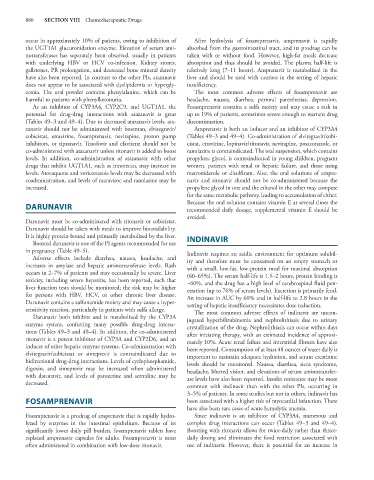Page 894 - Basic _ Clinical Pharmacology ( PDFDrive )
P. 894
880 SECTION VIII Chemotherapeutic Drugs
occur in approximately 10% of patients, owing to inhibition of After hydrolysis of fosamprenavir, amprenavir is rapidly
the UGT1A1 glucuronidation enzyme. Elevation of serum ami- absorbed from the gastrointestinal tract, and its prodrug can be
notransferases has separately been observed, usually in patients taken with or without food. However, high-fat meals decrease
with underlying HBV or HCV co-infection. Kidney stones, absorption and thus should be avoided. The plasma half-life is
gallstones, PR prolongation, and decreased bone mineral density relatively long (7–11 hours). Amprenavir is metabolized in the
have also been reported. In contrast to the other PIs, atazanavir liver and should be used with caution in the setting of hepatic
does not appear to be associated with dyslipidemia or hypergly- insufficiency.
cemia. The oral powder contains phenylalanine, which can be The most common adverse effects of fosamprenavir are
harmful to patients with phenylketonuria. headache, nausea, diarrhea, perioral paresthesias, depression.
As an inhibitor of CYP3A4, CYP2C9, and UGT1A1, the Fosamprenavir contains a sulfa moiety and may cause a rash in
potential for drug-drug interactions with atazanavir is great up to 19% of patients, sometimes severe enough to warrant drug
(Tables 49–3 and 49–4). Due to decreased atazanavir levels, ata- discontinuation.
zanavir should not be administered with bosentan, elvitegravir/ Amprenavir is both an inducer and an inhibitor of CYP3A4
cobicistat, etravirine, fosamprenavir, nevirapine, proton pump (Tables 49–3 and 49–4). Co-administration of elvitegravir/cobi-
inhibitors, or tipranavir. Tenofovir and efavirenz should not be cistat, etravirine, lopinavir/ritonavir, nevirapine, posaconazole, or
co-administered with atazanavir unless ritonavir is added to boost ranolazine is contraindicated. The oral suspension, which contains
levels. In addition, co-administration of atazanavir with other propylene glycol, is contraindicated in young children, pregnant
drugs that inhibit UGT1A1, such as irinotecan, may increase its women, patients with renal or hepatic failure, and those using
levels. Atovaquone and voriconazole levels may be decreased with metronidazole or disulfiram. Also, the oral solutions of ampre-
coadministration, and levels of maraviroc and ranolazine may be navir and ritonavir should not be co-administered because the
increased. propylene glycol in one and the ethanol in the other may compete
for the same metabolic pathway, leading to accumulation of either.
DARUNAVIR Because the oral solution contains vitamin E at several times the
recommended daily dosage, supplemental vitamin E should be
avoided.
Darunavir must be co-administered with ritonavir or cobicistat.
Darunavir should be taken with meals to improve bioavailability.
It is highly protein-bound and primarily metabolized by the liver. INDINAVIR
Boosted darunavir is one of the PI agents recommended for use
in pregnancy (Table 49–5). Indinavir requires an acidic environment for optimum solubil-
Adverse effects include diarrhea, nausea, headache, and ity and therefore must be consumed on an empty stomach or
increases in amylase and hepatic aminotransferase levels. Rash with a small, low-fat, low-protein meal for maximal absorption
occurs in 2–7% of patients and may occasionally be severe. Liver (60–65%). The serum half-life is 1.5–2 hours, protein binding is
toxicity, including severe hepatitis, has been reported, such that ~60%, and the drug has a high level of cerebrospinal fluid pen-
liver function tests should be monitored; the risk may be higher etration (up to 76% of serum levels). Excretion is primarily fecal.
for persons with HBV, HCV, or other chronic liver disease. An increase in AUC by 60% and in half-life to 2.8 hours in the
Darunavir contains a sulfonamide moiety and may cause a hyper- setting of hepatic insufficiency necessitates dose reduction.
sensitivity reaction, particularly in patients with sulfa allergy. The most common adverse effects of indinavir are uncon-
Darunavir both inhibits and is metabolized by the CYP3A jugated hyperbilirubinemia and nephrolithiasis due to urinary
enzyme system, conferring many possible drug-drug interac- crystallization of the drug. Nephrolithiasis can occur within days
tions (Tables 49–3 and 49–4). In addition, the co-administered after initiating therapy, with an estimated incidence of approxi-
ritonavir is a potent inhibitor of CYP3A and CYP2D6, and an mately 10%. Acute renal failure and interstitial fibrosis have also
inducer of other hepatic enzyme systems. Co-administration with been reported. Consumption of at least 48 ounces of water daily is
elvitegravir/cobicistat or simeprevir is contraindicated due to important to maintain adequate hydration, and serum creatinine
bidirectional drug-drug interactions. Levels of cyclophosphamide, levels should be monitored. Nausea, diarrhea, sicca syndrome,
digoxin, and simeprevir may be increased when administered headache, blurred vision, and elevations of serum aminotransfer-
with darunavir, and levels of paroxetine and sertraline may be ase levels have also been reported. Insulin resistance may be more
decreased.
common with indinavir than with the other PIs, occurring in
3–5% of patients. In some studies but not in others, indinavir has
FOSAMPRENAVIR been associated with a higher risk of myocardial infarction. There
have also been rare cases of acute hemolytic anemia.
Fosamprenavir is a prodrug of amprenavir that is rapidly hydro- Since indinavir is an inhibitor of CYP3A4, numerous and
lyzed by enzymes in the intestinal epithelium. Because of its complex drug interactions can occur (Tables 49–3 and 49–4).
significantly lower daily pill burden, fosamprenavir tablets have Boosting with ritonavir allows for twice-daily rather than thrice-
replaced amprenavir capsules for adults. Fosamprenavir is most daily dosing and eliminates the food restriction associated with
often administered in combination with low-dose ritonavir. use of indinavir. However, there is potential for an increase in

